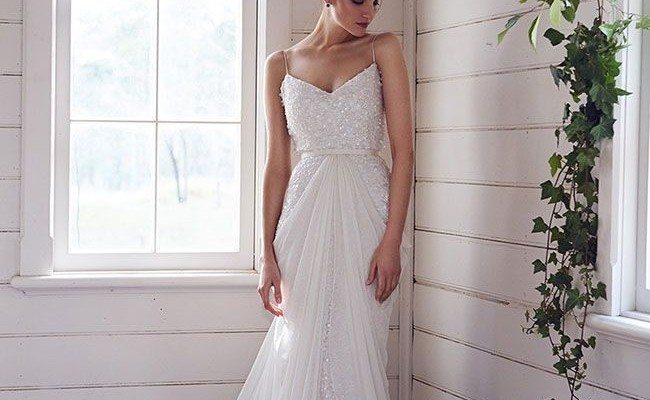The tricks of the train; the art of the bustle. We take these time-shrouded mysteries and lay it all out for the bride-to-be.
Back in the Middle Ages, when fine fabric was scarce, the length of your train was a quick way to impress the crowd with your wealth … and standing.
But by the Victorian age, this simple equation got complicated. And under Queen V., bustling became an art form, complete with all kinds of floral treatments and fussily interwoven ribbons and lace.
Today, we’re back to simpler lines. And still, a gown with a train suggests formality. The longer the train, the more formal the wedding, usually.
So, what is a train exactly? Most of us have some idea: it’s that extension in the back of the skirt that trails you when you walk down the aisle. As it turns out, there are two major types: built-in and detachable.
Built-ins are sewn into the actual skirt pattern when the dress is made. These are the kind you pull up and bustle after the ceremony. So a detachable train, logically, is a separate component, not sewn in.
Typically, you ditch your detachable after the ceremony (though I’ve seen a bride or two bustle them every so often, to keep that Gigi look going for the party).
Trains, from Short to Long
The Sweep: Typically extends a foot or so past the hemline.
The Chapel: Considered formal. Extends about 2 feet beyond the hemline. Tres chic right now.
The Cathedral: Formal. Generally a 3 foot extension from the hemline. Needs bustling treatment post ceremony.
The Royal: Very long. Diana Spencer’s was twenty-five feet! Ultra-formal look for big churches and cathedral ceremonies.
Popular Styles in What Lies Behind
Watteau: Named for the eighteenth-century painter who popularized his models in them. They attach at the shoulder and fall to the hemline or beyond.
Panel Train: Fabric in a long strip or A-line shape. Typically attach to the waist, though sometimes they’re fastened to the back or shoulders.
Bouffant Panel: A type of semi-skirt gathered onto a band at the back waist. Sometimes extends the hip area. Popular with sheath and A-line silhouettes. Check out Audrey Hepburn’s party dress in Sabrina for a classic example.
Overskirt: Gathered or fitted onto a belt you can unhook for the reception. Might be composed of solid fabric, like duchesse satin, or something transparent like organza.
Fishtail: Either a built-in extension or godet (triangle of fabric inserted in the seam).
Tricks of the Train
If your heart’s set on an ultra- formal gown and you’re petite, concentrate on exquisite fabric or embroidery, not length. A sweep train and/or chapel veil is about as far as you can go and stay in proportion.
Heavier? Go any length. But keep in mind: thick, textured, adorned fabrics won’t show you at your best. If you’re tall and slender, lucky you! Choose any length and fabric that fits your fancy … without over-embellishing.
The 411 on Formals
Evening gown silhouettes in lightweight fabrics are pretty straightforward, and they come with both built-in and detachable trains. Sheath silhouettes come with mostly detachable ones, unless they sport a fishtail treatment.
But if your heart’s set on an A-line or ballgown in medium to heavyweight fabrics like Duchesse and Peau de Soie, your train will probably be built-in, and chapel or cathedral-length. These are the more formal gowns — and when you visit a salon, you’re just not as likely to see them displayed.
If you do, or a sales consultant brings one out, take a close look at how the gown holds its shape on the hanger or dress form. If it’s hanging up, you’ll probably see it on a molded form-hanger, bustled and/or displayed at least a foot apart from its neighbors. If it’s on dress form, great — that’s almost as good as you wearing it. You’ll see it at its best.
Also See:
- Sophisticated Wedding Ball-Gowns For Older Brides
- Gorgeous, Knee-Length Getaway Wedding Gowns for Your Second Time Around
- Sexy, Sheath Wedding Gowns for Your Second Walk Down the Aisle
- Older Bride Wedding Dresses We Spotted (& LOVED) from Spring 2015 Bridal Fashion Week
- 13 Gorgeous Wedding Dresses for Older Brides
- Second Wedding Dresses for An Older (& Still Sexy) Bride
- WOW! Wedding Gowns With Textured Skirts
- Guide to Wedding Dress Shopping
Glide Like a Bride
Things to look for in these very formal gowns: check whether or not the skirt (read: skirt, not the underslip) seems to have a structure that stands on its own. It should. This structure reveals how the gown is lined and hemmed.
When you pick up the skirt — including the train — and look closely at the hemline, you’re likely to find a 3-6” wide band of horsehair. That’s the clear and meshy edging at the hemline that gives the bottom of the dress some flex as well as firmness. Notice how the skirt and train extension seem to hold that precision shape. It’s the horsehair that gives the skirt that full, gliding Cinderella flair when you move instead of swishing from side to side (and here you thought she was just a pro!).
Typically, horsehair is sewn on the inside of the hem. But most designers today bring the skirt lining over the horsehair edging completely, leaving a clean a finish inside and out. Which is useful — since you might find yourself walking over brick or cobblestones that could trip you up or get caught up in the horsehair. With that clean finish work inside, when you lift your skirt to walk up stairs, the horsehair stays demurely hidden. Ahhh.
The Art of the Bustle
Bustle, bustled, bustling. These fusty-sounding words translate into sweet, sweet freedom at your reception. In a bustle, your skirt’s gathered and tacked up so you can do the Mashed Potato whenever the mood moves you. Once a gown is bustled, it goes through a kind of metamorphosis. And so does the bride in it.
There are two main approaches to bustling: overbustles and underbustles (the French style). Usually, bustling is secured with hooks and/or ribbon, typically narrow strips of grosgrain.
Overbustling is the simplest approach, good for that obliging Maid of Honor. It involves picking up and tacking the skirt to the waist for chapel and cathedral lengths, or behind the knee for sweeps. Underbustling goes the other way—down and under, fastening to points on the under slip. Longer trains can handle a combination of over and under-bustling at once … often, with stunning results.
Additional or custom bustling is done after you finish the bodice fitting. How many bustle points you might add is up to you and your alterations person.
To Bustle, or Not?
But keep in mind: not every dress bustles beautifully. Ballgowns with skirts in flimsy layers, for one … like tulle or organza. All those layers add up to a hassle! After all, bustling’s done layer-by-layer, which costs time and money for a gown like this — for most brides, it isn’t worth it. Also, some gowns with sweep trains, godets or fishtails don’t bustle well.
But overall, most dresses do bustle beautifully, and are a joy to wear. And as every bride knows, a bustled train remains one of the most elegant and romantic elements of any wedding gown.
Amy-Jo Tatum has been a custom designer of bridal gowns and accessories for twenty-two years. She specializes in one-of-a-kind gowns in imported silks and laces. Visit her site at www.amyjotatum.com.


